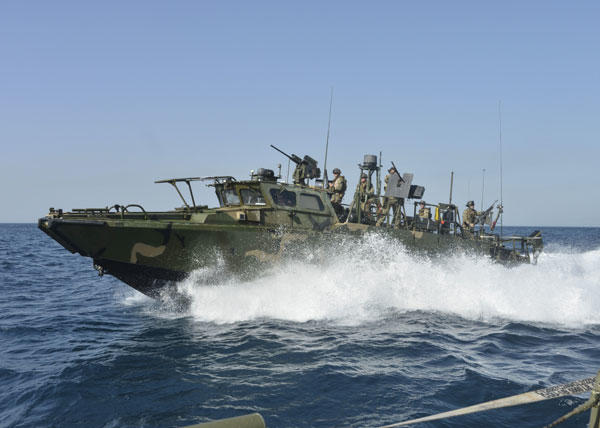The U.S. Navy said Monday that the 10 American sailors aboard two patrol craft seized at gunpoint by Iran last week had "deviated" from their assigned route although Iran claimed that the sailors' GPS devices were in working order.
A timeline on the international incident that threatened to unravel the nuclear deal with Iran and the swap of prisoners left unclear how the patrol craft became lost in the Persian Gulf on a routine daylight move between Kuwait and Bahrain.
There was also a "mechanical issue" aboard one of the boats but "it's not clear the crew was aware of their exact location" when two small Iranian craft approached with Iranian Revolutionary Guards aboard brandishing weapons, U.S. Naval Forces Central Command said in a statement.
Statements Monday issued by Iran's legislature added to the mystery of how the sailors came to be stopped in the water three miles inside Iran's territorial waters off Farsi island in the middle of the Persian Gulf.
Defense Secretary Ashton Carter and other high-ranking officials said last week that a "navigational error" appeared to be the cause and suggested that an equipment malfunction may have sent the boats off course.
However, a statement from Iran's parliament cited Iranian Revolutionary Guard Corps officials as saying that the U.S. sailors should have been aware of their location.
"The coordinates recorded on the GPS devices taken from the 10 U.S. marines (sic) confirmed their trespassing" into waters off heavily-guarded Farsi island, the semi-official Fars news agency reported of the parlimentary statement.
The statement from U.S. Naval Forces Central Command said, "A post-recovery inventory of the boats found that all weapons, ammunition and communication gear are accounted for minus two SIM cards that appear to have been removed from two hand-held satellite phones."
Photos and video of the incident released by Iranian media had shown numerous automatic weapons and belts of ammunition being confiscated by the Iranians and lined up as a display on the deck of one of the captured boats.
In giving the timeline, the command said it was only preliminary and a full account would come from an investigation that began on Jan. 14, the day after the two boats and the 10 sailors, including nine males and one female, were returned and were picked up by the U.S. guided-missile cruiser Anzio.
It was unclear whether the 10 sailors, who were all reported in good health and undergoing debriefings, would face any disciplinary action.
The timeline made no mention of the sailors being forced to kneel, hands clasped behind their heads, or the apparent apology for the "mistake" in straying into Iranian waters made by one of the sailors and shown on Iranian media.
The two 49-foot Riverine Command Boats left Kuwait en route to the Navy's Fifth Fleet headquarters in Bahrain, a trip of about 290 miles, at 12:53 a.m. Iran time, the command said.
"The planned transit path for the mission was down the middle of the Gulf and not through the territorial waters of any country other than Kuwait and Bahrain," the command said. A refueling rendezvous with the Coast Guard Cutter Monomoy was planned for 5 p.m. local time.
Ten minutes after the scheduled refueling was supposed to have taken place, the command "received a report that the RCBs were being queried by Iranians."
At approximately 5:29 p.m., the command "was advised of degraded communications with the RCBs." At 5:45 p.m., the command "was notified of a total loss of communications with the RCBs," indicating they were in Iranian custody.
The command said "initial operational reports showed that while in transit from Kuwait to Bahrain the RCBs deviated from their planned course on their way to the refueling. The command investigation will determine what caused the change in course and why the RCBs entered into Iranian territorial waters in the vicinity of Farsi Island."
Once contact was lost, the Navy began a "massive" search and rescue operation. At the time of the incident, two aircraft carrier strike groups were within 45 miles of three-square mile Farsi island, which is about 135 miles from Bahrain.
The carrier USS Harry S. Truman was about 45 miles southeast of Farsi island and the French carrier Charles De Gaulle was about 40 miles north of Farsi, the command said.
Iran was notified of the search and rescue operation, and then at 9:15 p.m., the cruiser Anzio "received a communication from Iran saying that the RCB sailors were in Iranian custody and were 'safe and healthy,'" the command said.
The timeline also noted that "at some point" during the transit from Kuwait to Bahrain "one RCB had indications of a mechanical issue in a diesel engine which caused the crews to stop the RCBs and begin troubleshooting."
"This stop occurred in Iranian territorial waters, although it's not clear the crew was aware of their exact location. While the RCBs were stopped and the crew was attempting to evaluate the mechanical issue, Iranian boats approached the vessels."
"Initial operational reports indicate there was a verbal exchange between the sailors and the Iranians but no exchange of gunfire," the command said. More Iranian boats arrived and "At gunpoint, the RCBs were escorted to a small port facility on Farsi Island where the U.S. Sailors disembarked and were detained for approximately 15 hours," it said.
Rear Adm. Ali Fadavi, commander of the naval branch of the Revolutionary Guards, was quoted as saying by official Iranian media,"We have concluded that passage of Americans in our territorial waters was not a hostile passage or for espionage or similar acts. They were positioned in that area due to the failure of their navigation systems and they were not aware of being close to Farsi Island."
The seizure of the two U.S. boats came hours before President Barack Obama was to make his State of the Union address and set off a flurry of diplomatic activity by Secretary of State John Kerry to gain their release.
The brief capture also came as the U.S. and allies were about to reach a milestone in the Joint Comprehensive Plan of Action in which Iran agreed to rein in its nuclear programs in exchange for the lifting of sanctions. A side agreement with the U.S. included an exchange of prisoners.
Republican presidential contenders lined up to criticize President Obama for the incident in the Gulf. The reaction of Sen. Ted Cruz, a Republican from Texas, was representative.
"Any nation that captured our military officers, captures our soldiers, should face serious repercussions," Cruz said on "Fox News Sunday." "The only reason they were seized is because of the weakness of Barack Obama."
In a background briefing at the White House, senior administration officials rejected the Republican criticism.
"If we did not have these diplomatic channels with the Iranians that have been established over the last two or three years, it is very likely that our sailors who had gone into Iranian waters would still be detained there today," a senior administration official said.
"If we did not have this diplomatic channel with Iran, we certainly would not have our Americans coming home," the official said.
--Richard Sisk can be reached at Richard.Sisk@Military.com.





























